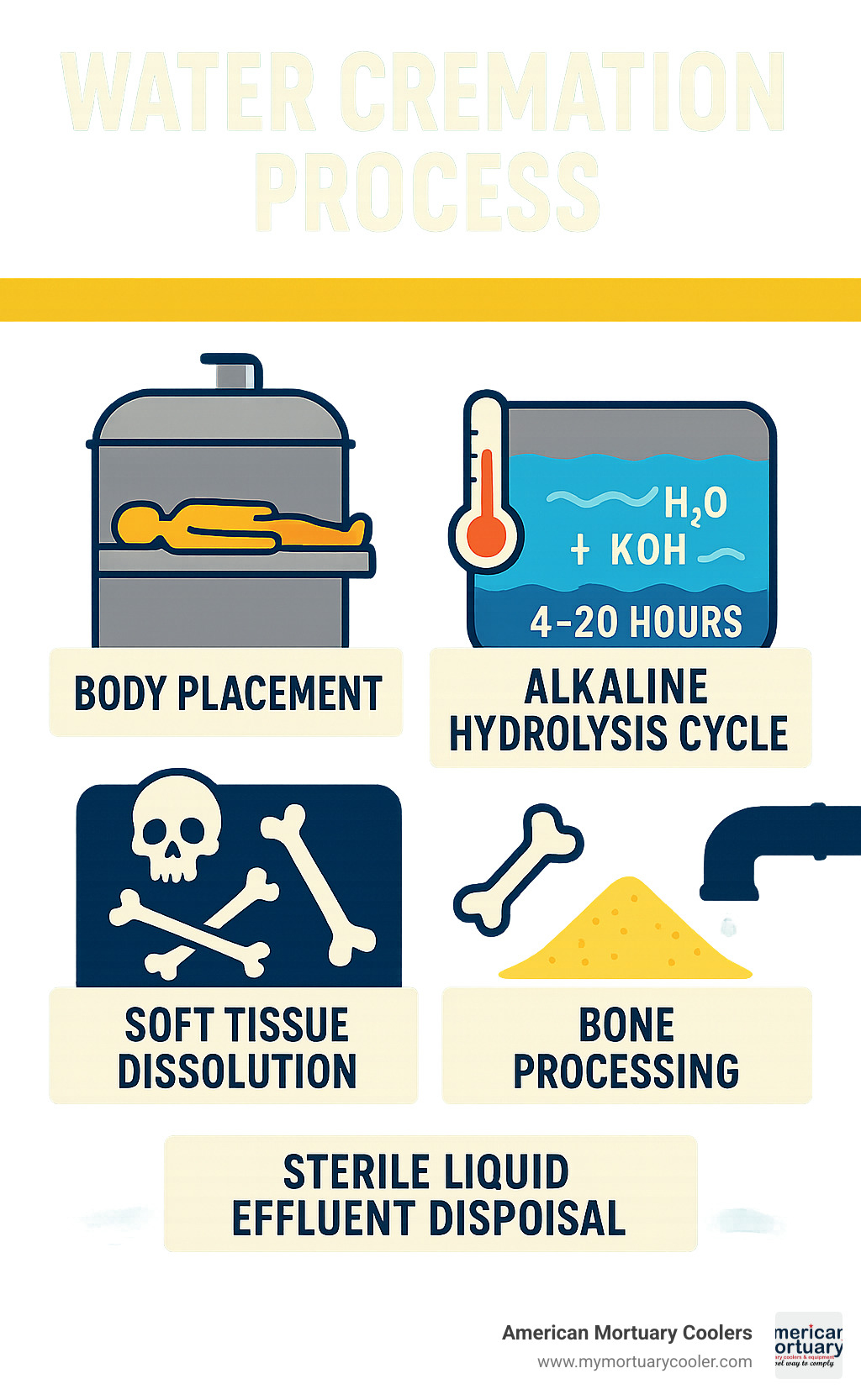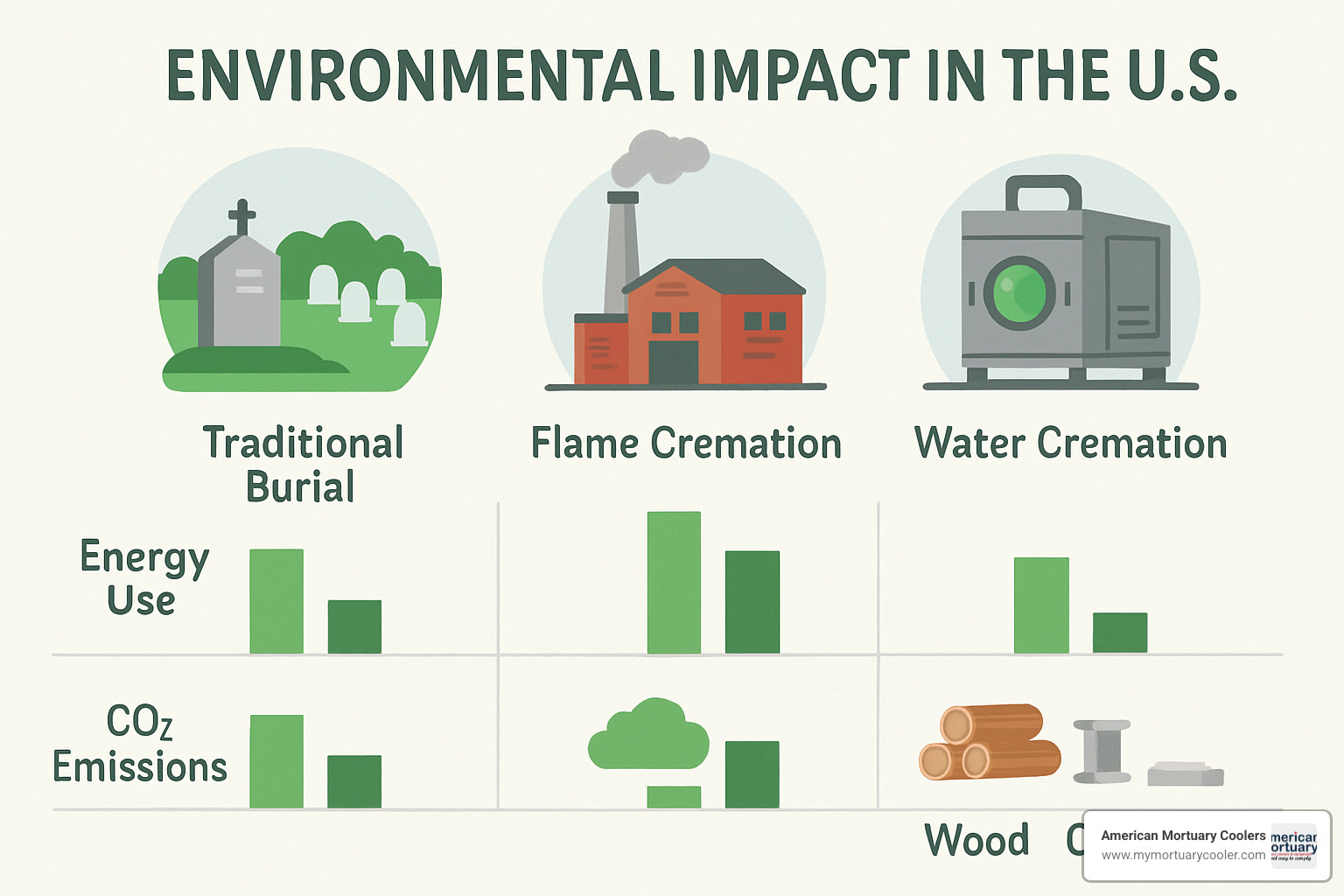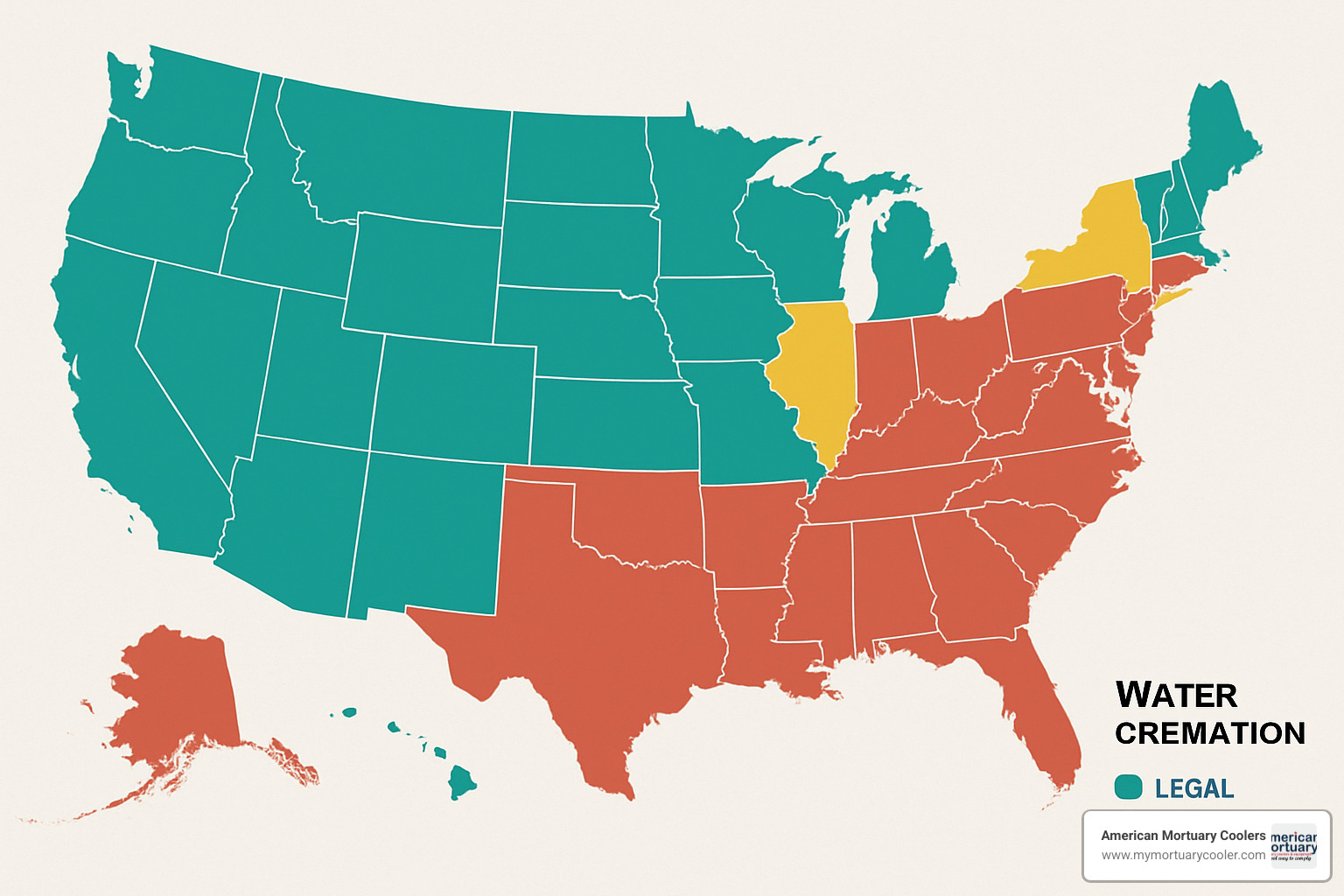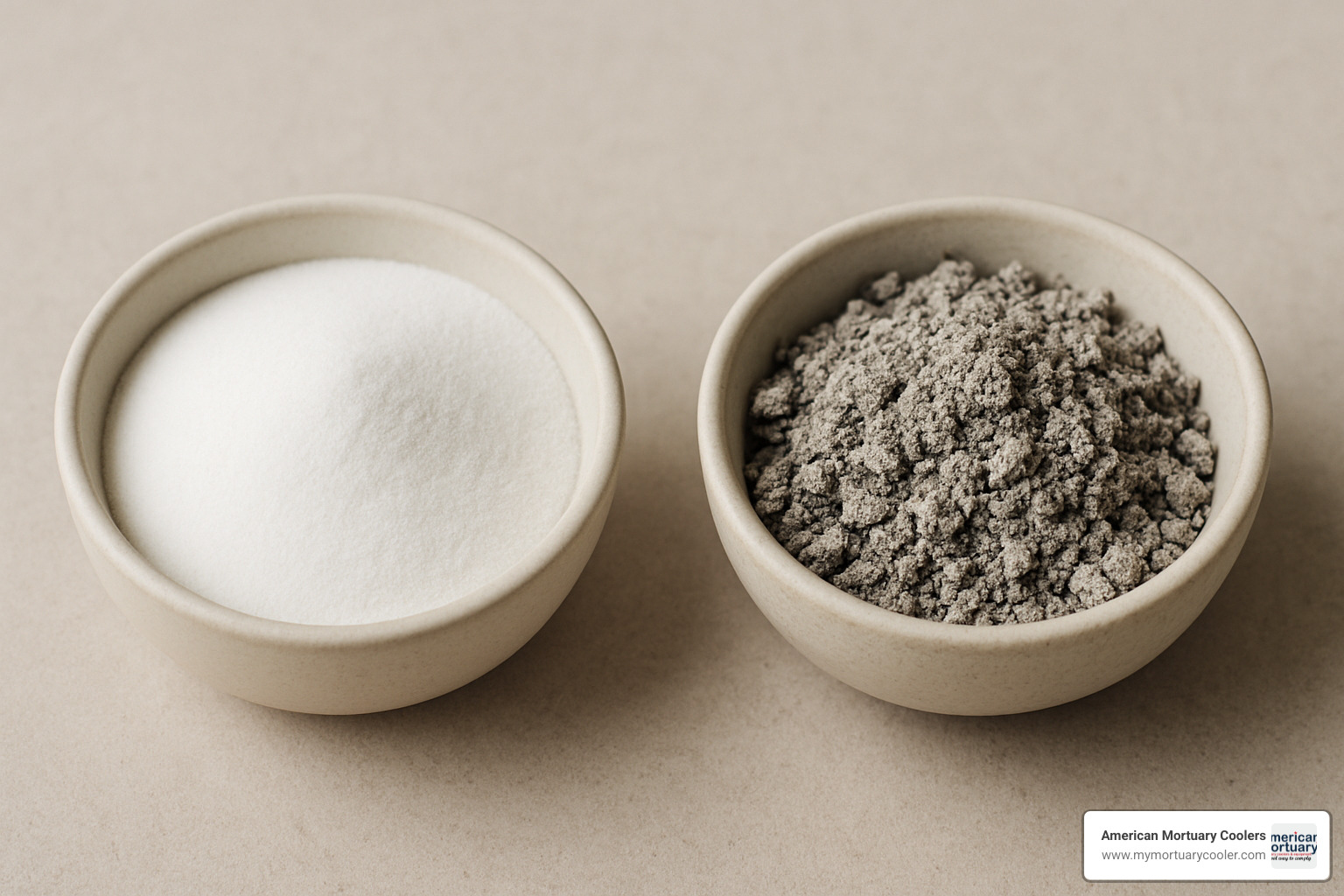The Growing Wave of Environmental Consciousness in Death Care
Is water cremation better than traditional flame cremation or burial? The short answer is yes, for most environmental and practical considerations:
- Energy Use: 90% less energy than flame cremation
- Carbon Footprint: 75% lower emissions
- Temperature: 300°F vs 1,800°F for flame cremation
- Mercury Release: Zero mercury vapors vs 500+ pounds annually from flame cremation
- Remains Volume: 20-30% more ashes returned to families
- Cost: $1,500-$3,500 vs $6,280 for flame cremation, $8,300 for burial
When Samantha Sieber got that unexpected New Year's Day call from BBC World News asking her to explain aquamation on live TV in 30 minutes, she knew something big was happening. More families are asking funeral directors about water cremation as climate change concerns grow and 60% of people surveyed say they want to explore "green" funeral options - up from 55.7% just two years ago.
This shift isn't just about being eco-friendly. Water cremation uses alkaline hydrolysis - the same natural process that happens in soil, just faster and in a controlled environment. Instead of burning bodies at 1,800°F with fossil fuels, it gently dissolves soft tissue at 300°F using heated water and potassium hydroxide.
The numbers tell a compelling story. Traditional burial in the U.S. consumes 30 million board feet of hardwoods, 2,700 tons of copper and bronze, and 1.6 million tons of concrete annually. Flame cremation releases over 500 pounds of CO₂ per body - equivalent to driving 600 miles. Water cremation produces virtually no direct emissions and uses one-seventh the energy.
As Mortuary Cooler and a national-level mortuary cooler supplier, I've seen how funeral directors are adapting to meet families' changing values around is water cremation better for both the environment and their loved ones. The funeral industry is evolving toward more sustainable practices, and understanding these options helps professionals serve families better.

What Is Water Cremation & How Does It Work?
Water cremation goes by several names - alkaline hydrolysis and aquamation are the most common. But whatever you call it, this process represents a gentle alternative to traditional cremation that many families find comforting.
Here's what makes it different: instead of flames reaching 1,800°F, water cremation uses a heated water bath at just 300°F. The body is placed in a pressurized stainless steel vessel filled with 95% water and 5% potassium hydroxide - the same compound used in soap making.
The process takes anywhere from 4 to 20 hours, depending on the system used. High-temperature, high-pressure systems work faster, completing their cycle in 4-6 hours. Lower-temperature systems that operate at atmospheric pressure take longer - usually 14-16 hours. During this time, the alkaline solution gently circulates, breaking down soft tissues through the same natural process that happens in soil.

What's remarkable about this process is how precisely controlled it is. Modern water cremation systems monitor temperature, pressure, and pH levels throughout the entire cycle. Medical implants like pacemakers, joint replacements, and dental work remain completely intact and can be safely recovered for recycling.
The energy efficiency is impressive too. The entire process uses about 6,000 cubic feet of natural gas equivalent in energy - but it's delivered through electricity rather than direct combustion, making it far more efficient than flame cremation.
Water cremation isn't new technology. The first commercial water cremation was performed at Albany Medical College in 1993, and the process has been refined over three decades. Today's systems are sophisticated pieces of equipment that funeral directors can operate safely and reliably.
Scientific research on effluent safety confirms what many families want to know: is water cremation better for safety? The answer is yes - the process produces no harmful emissions and creates sterile byproducts that are completely safe for disposal.
The Science Behind the Gentle Process
The chemistry behind water cremation is beautifully simple. When organic matter meets heated water at high pH levels, hydrolysis occurs - the exact same process that breaks down all organic material in nature. The potassium hydroxide acts as a catalyst, raising the pH to around 14, which speeds up natural decomposition.
This isn't burning or harsh dissolving. Instead, the process gently separates the chemical bonds in soft tissue, mimicking what happens in soil over many years. What remains is a sterile liquid containing amino acids, peptides, sugars, and salts - essentially the same nutrients found in healthy soil after natural decomposition.
Only the calcium phosphate of bones remains after the soft tissue dissolves. These bones are then processed into a fine, white powder that families receive as cremated remains.
The sterile nutrient liquid byproduct is remarkably clean. It contains no tissue, no DNA, and no harmful chemicals. It's so pure that it can be safely discharged into municipal wastewater systems. Some families even choose to use this "Tree Tea" as fertilizer for plants, creating a living memorial for their loved one.
This gentle process truly mimics natural decomposition - just in a controlled environment that takes hours instead of years.
Is Water Cremation Better? Environmental & Health Comparison
The environmental differences between disposition methods are striking when you look at the actual numbers. Is water cremation better for our planet? The answer becomes clear when we compare the real-world impact of each option.
Traditional flame cremation burns hot and dirty. Every single cremation consumes about 6,000 cubic feet of natural gas - enough to heat an average home for two weeks. That intense 1,800°F fire releases over 500 pounds of CO₂ into the atmosphere, which is like driving from New York to Detroit in terms of carbon emissions.
But the pollution doesn't stop there. Flame cremation releases 219 different pollutants including dioxins, furans, and carcinogenic toxins. Perhaps most concerning, those 8,500 pounds of mercury vapor released annually from dental fillings eventually settle into our water systems and food chain.
Water cremation operates completely differently. There's no combustion, no direct CO₂ emissions, and zero mercury release. The gentle 300°F process uses about 90% less energy than flame cremation. Since it runs entirely on electricity, facilities can even power it with renewable energy sources like solar or wind.

Traditional burial creates its own environmental challenges. American cemeteries consume 30 million board feet of hardwood annually - enough to build 3,000 homes. Add in the 104,272 tons of steel and 1.6 million tons of concrete, and burial becomes a massive resource drain that continues forever.
Cemetery land use keeps expanding too, converting natural habitats into maintained landscapes that require ongoing chemical treatments. The embodied resources in caskets, vaults, and monuments represent enormous environmental costs that water cremation avoids entirely.
The carbon footprint difference is remarkable. While flame cremation releases stored body carbon as CO₂, water cremation actually captures that carbon in the liquid effluent. This makes the process carbon-negative in many cases, especially when the nutrient-rich liquid is used to grow plants.
More info about going green with water cremation shows how this choice can align with families' environmental values while providing a meaningful farewell.
Liquid By-Product: Waste or Resource?
Here's where water cremation gets really interesting. That sterile liquid left after the process isn't waste - it's actually a valuable resource. The effluent contains amino acids, peptides, sugars, and salts that are essentially the same nutrients you'd find in high-quality compost.
Municipal wastewater treatment facilities welcome this liquid because it's completely sterile and actually helps the beneficial bacteria that clean our water. The pH needs adjusting, but that's a simple process that treatment plants handle routinely.
Some forward-thinking facilities offer families the liquid as "Tree Tea" - a sterile fertilizer perfect for nourishing memorial gardens or special plants. It's a beautiful way to create living memorials that grow stronger over time.
The agricultural potential is significant too. This nutrient-rich liquid can benefit farms and gardens while avoiding the environmental problems of synthetic fertilizers. It's completely organic and free from harmful chemicals.
Water cremation also excels at breaking down pharmaceuticals that would otherwise persist in the environment. Chemotherapy drugs, embalming chemicals, and other medical compounds get safely neutralized during the process. This makes it especially valuable for people who underwent medical treatments with persistent chemicals.
Handling Implants & Non-Organic Materials
One practical advantage that families often appreciate is how water cremation handles medical implants. The gentle process leaves everything non-organic completely intact and undamaged.
Pacemakers that could explode during flame cremation pose zero safety risks in water cremation. Joint replacements, surgical screws, dental work - everything comes out in perfect condition. This creates real opportunities for recycling valuable medical-grade metals like titanium.
The safety benefits extend to facility operators too. No risk of explosions, no toxic fumes, and no damaged equipment from metal implants. It's a much safer working environment all around.
Families sometimes ask about jewelry or other personal items. While these should be removed beforehand, anything accidentally left behind will be recovered intact rather than destroyed. It's just another way that water cremation proves gentler for everyone involved.
Costs, Availability & Cultural Considerations
When families are exploring their options, cost often becomes a deciding factor. The good news? Is water cremation better for your budget? In most cases, yes. Water cremation typically costs between $1,500 and $3,500, which sits comfortably below flame cremation at $6,280 and traditional burial at $8,300 according to 2023 National Funeral Directors Association data.
These savings aren't just good for families - they make sense from an operational standpoint too. Water cremation facilities don't burn fossil fuels, which keeps ongoing costs lower. There's no need for expensive pollution control equipment since the process produces no harmful emissions. The gentle 300°F process also means less wear and tear on equipment compared to the intense heat of flame cremation.
But here's the catch: you can't choose water cremation everywhere yet. As of 2024, the process is legal in 26 U.S. states, with more legislation moving through state governments each year. It's one of those situations where demand is outpacing regulation, and lawmakers are still catching up to what families actually want.

The international picture looks more promising. Canada has approved water cremation in several provinces, and pilot programs are showing success in the United Kingdom. Countries with strong environmental commitments are naturally drawn to a process that aligns with their sustainability goals.
Scientific research on consumer trends confirms what we're seeing in the field - 60% of consumers now express interest in green funeral options. That's up from 55.7% just two years ago, showing how quickly attitudes are shifting.
Where Can You Choose It Today?
If you're in one of the 26 states where water cremation is legal, you're in luck - though finding a provider might still take some detective work. Major markets like California, Florida, Illinois, and New York have approved the technology, with facilities gradually expanding their service areas.
Hawaii recently joined the list, and their reasoning was particularly thoughtful. The legislation specifically acknowledged how water cremation aligns with traditional Polynesian values around returning to the ocean - a beautiful example of how this process can honor cultural traditions in ways that flame cremation simply can't.
The challenge isn't just legal availability - it's practical availability. The specialized equipment required represents a significant investment for funeral homes. Many directors are still evaluating whether to add the service, weighing customer demand against equipment costs. However, the pioneering facilities that have made the leap report strong demand and high customer satisfaction.
Canada has been more welcoming overall, with provinces like Ontario and British Columbia leading the way. The process fits naturally with Canadian environmental values and has faced fewer regulatory challenges than in some U.S. states.
Across the pond, the Netherlands has conducted successful pilot programs, while the United Kingdom is working through regulatory frameworks for broader approval. It's encouraging to see how the technology's environmental benefits are driving policy changes worldwide.
Will My Faith Allow It? — is water cremation better for my beliefs
This is often the first question families ask, and it's completely understandable. Is water cremation better for your religious beliefs? The answer depends on your specific faith tradition, but many religious communities are finding the process more acceptable than they initially expected.
Christian denominations generally view water cremation favorably. Many see it as a gentler, more respectful alternative to flame cremation. The process mirrors natural decomposition, which aligns beautifully with "dust to dust" theology. Plus, the environmental stewardship aspect resonates with many Christians who see caring for creation as part of their faith.
Jewish perspectives are more complex but increasingly positive. While Orthodox Judaism generally prohibits cremation, some Jewish families who choose cremation prefer the water process over flame cremation. The historical associations with fire make water cremation feel more respectful to some families, though this varies greatly among individuals and communities.
Hindu and Buddhist traditions, which often accept cremation as part of their beliefs, generally welcome water cremation too. The process's connection to water - a sacred element in many Eastern traditions - can actually improve its spiritual significance. The gentle nature of the process aligns with concepts of respect for the body.
Islamic perspectives vary among scholars, with some viewing water cremation as more natural than flame cremation. However, burial remains the strongly preferred method in most Islamic traditions, so this is definitely a conversation to have with your religious leader.
The key is having open conversations with your faith community. Many religious leaders are still learning about water cremation themselves, and they appreciate families who bring thoughtful questions rather than assumptions.
Comparing the Ashes & Family Experience
When families choose water cremation, they often find that the remains tell a different story than what they might expect from traditional flame cremation. The differences start with volume - water cremation produces 20-30% more ashes because the gentle process preserves more of the bone structure rather than reducing it to fragments.
The visual and tactile differences are striking. Water cremation creates a fine, white, velvety powder that feels softer and more pleasant to handle. Many families describe it as almost silk-like, contrasting sharply with the gray, gritty texture of flame cremation ashes. The uniform white color comes from the gentle temperature that doesn't char or discolor the bone material.

The increased volume means families need to plan for larger urns, but this creates opportunities rather than problems. Some families divide the ashes among multiple family members, allowing everyone to keep a portion close. Others use different portions for various memorial purposes - some for scattering, some for keepsake jewelry, and some for permanent display.
What makes water cremation ashes truly special is their biodegradable nature. Unlike flame cremation ashes, which can actually harm soil and plants due to high pH and chemical residues, water cremation ashes benefit the environment where they're scattered. They act like a gentle fertilizer, nourishing the earth rather than creating dead zones.
This environmental friendliness opens up more scattering options. Families can scatter in gardens, forests, or waterways without worrying about ecological damage. Some create memorial gardens where the ashes help flowers and trees grow as living tributes.
More info about understanding process helps families prepare for what to expect throughout their experience with this gentler alternative.
Receiving the Remains: What Families Should Expect — is water cremation better for closure
The experience of receiving remains from water cremation often provides families with unique closure opportunities that aren't available with other methods. Is water cremation better for the grieving process? Many families tell us it absolutely is, and here's why.
First, families have a choice that no other method offers - they can receive both the bone ashes and the sterile liquid effluent. This "Tree Tea" isn't just a byproduct; it's a sterile, nutrient-rich liquid that can nourish plants, trees, or gardens. Imagine creating a memorial garden where your loved one literally continues to nurture new life. Some families plant trees with this liquid and watch them grow for years as living memorials.
The increased volume of ashes provides remarkable flexibility for memorialization. Instead of having just enough ashes for one purpose, families can honor their loved one in multiple ways. They might scatter some ashes at a favorite beach, keep some in a beautiful urn at home, and have some incorporated into memorial jewelry or glass art. The fine, white texture makes these artistic applications more beautiful and meaningful.
Scattering becomes less complicated with water cremation ashes because they're completely biodegradable and non-toxic. While you should always check local regulations, many restrictions that apply to flame cremation ashes don't apply here. Families can scatter in natural areas knowing they're actually helping rather than harming the environment.
Perhaps most importantly, many families find emotional comfort in the gentle nature of the entire process. Knowing their loved one was treated with a method that mimics natural decomposition - without burning, without harsh chemicals, without violence - helps them feel more at peace. It's a final act of care that aligns with how we'd want to be treated ourselves.
The white, soft texture of the ashes often surprises families in a positive way. Instead of the stark gray reminder of fire and destruction, they receive something that feels pure and peaceful. Many families say handling these ashes feels more like a blessing than a burden.
Frequently Asked Questions About Water Cremation
When families start learning about water cremation, they naturally have questions. As someone who works with funeral directors across the country, I hear the same concerns come up again and again. Let me address the big three that almost everyone asks about.
Is water cremation better for the environment?
Is water cremation better for our planet? The answer is a resounding yes, and the numbers tell an impressive story.
Water cremation uses 90% less energy than flame cremation and produces 75% fewer carbon emissions. While flame cremation burns at 1,800°F using massive amounts of natural gas, water cremation operates at a gentle 300°F using electricity that can come from renewable sources.
The environmental benefits go way beyond energy savings. Flame cremation releases 219 known pollutants including mercury vapors from dental fillings - about 8,500 pounds annually in the U.S. alone. Water cremation produces zero toxic air pollutants, no dioxins, no furans, and no mercury emissions.
Traditional burial isn't much better for the environment. Americans bury 30 million board feet of hardwood, 104,272 tons of steel, and 1.6 million tons of concrete every year. That's enough concrete to build a two-lane highway from New York to Detroit.
Water cremation sidesteps all these resource demands. The remains are completely biodegradable and can actually benefit ecosystems where they're scattered, unlike flame cremation ashes which can be toxic to plants due to their high pH.
Does it consume too much water?
This question makes perfect sense - after all, it's called "water cremation." But the reality might surprise you.
Each water cremation cycle uses 80-100 gallons of water, which sounds like a lot until you realize that's less than most Americans use at home in a single day. The average person uses about 80-100 gallons daily for showers, laundry, dishes, and other household needs.
The water isn't wasted, either. It's recycled within the system throughout the process, and the final sterile effluent can safely enter municipal wastewater treatment. Some facilities even offer this nutrient-rich liquid to families as "Tree Tea" for nourishing memorial gardens.
When you look at the bigger picture, water cremation's water footprint is tiny compared to traditional burial and flame cremation. Those methods require enormous amounts of water for resource extraction, manufacturing, and ongoing cemetery maintenance - far more than the direct water use in aquamation.
How long does it take and is any DNA left?
The timing of water cremation depends on which type of system the facility uses. High-temperature systems complete the process in 4-6 hours, while atmospheric pressure systems take 14-16 hours. Most facilities run overnight cycles, so timing rarely affects families' planning.
As for DNA, water cremation is just as thorough as flame cremation at breaking down all biological material. The alkaline hydrolysis process completely dissolves all soft tissue and genetic material, leaving only sterile calcium phosphate from bones. This bone material is then processed into the fine white powder that families receive.
No DNA remains that could be used for any type of analysis - the process is complete and irreversible, just like flame cremation. The only difference is that water cremation accomplishes this breakdown gently, using chemistry instead of intense heat.
The thoroughness of the process is actually one of its strengths. The sterile liquid byproduct contains only amino acids, peptides, and salts - the same components you'd find in natural compost. Nothing biological survives the process.
Conclusion
The future of death care is changing, and water cremation is leading the way. After examining the science, costs, environmental impact, and family experiences, the question is water cremation better has a clear answer for most people: absolutely.
Think about what matters most to families today. They want to honor their loved ones while protecting the planet for their children and grandchildren. They're looking for options that align with their values without breaking their budgets. Water cremation delivers on all these fronts.
The environmental benefits alone are remarkable. Using 90% less energy than flame cremation while producing 75% fewer emissions isn't just impressive - it's transformative. When you consider that traditional methods release over 500 pounds of CO₂ per person and consume massive amounts of hardwood, steel, and concrete, water cremation's gentle approach feels like common sense.
But this isn't just about numbers on a spreadsheet. It's about families like yours finding peace in their choices. The 20-30% more ashes that water cremation provides means more opportunities for meaningful memorials. The white, velvety texture that families consistently prefer. The option to receive sterile "Tree Tea" that can nourish living memorials for years to come.
The momentum is undeniable. From 26 states and growing to international adoption across Canada and Europe, water cremation is becoming mainstream. Funeral directors tell us their families are asking about it more often, and satisfaction rates are consistently high.
At American Mortuary Coolers, we've watched this change unfold across the funeral industry. Our custom cooling solutions support funeral homes whether they're offering traditional services or embracing new technologies like water cremation. We're proud to help funeral professionals adapt to meet families' changing needs while maintaining the dignity and care that defines great funeral service.
The shift toward is water cremation better isn't just about environmental consciousness - though that's certainly part of it. It's about giving families choices that feel right for their values, their budgets, and their vision of how they want to be remembered.
Your final act on Earth can be one of healing rather than harm. Water cremation offers that possibility, turning what was once an environmental burden into an opportunity for positive impact. That's not just better for the planet - it's better for the people who love you and want to honor your memory in a way that reflects who you were.
More info about aqua cremation explained provides additional insights into this transformative process that's reshaping how we think about death care.
















